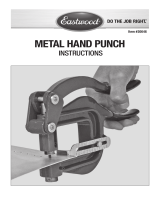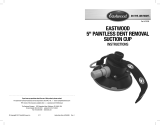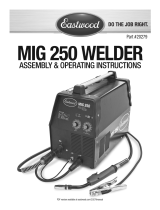Page is loading ...

8PC COMPRESSION TEST KIT
INSTRUCTIONS
© Copyright 2016 Easthill Group, Inc. 9/16 Instruction item #31351Q Rev 0
If you have any questions about the use of this product, please contact
The Eastwood Technical Assistance Service Department: 800.544.5118 >> email: techelp@eastwood.com
PDF version of this manual is available online >> eastwood.com/31351manual
The Eastwood Company 263 Shoemaker Road, Pottstown, PA 19464, USA
US and Canada: 800.345.1178 Outside US: 610.718.8335
Fax: 610.323.6268 eastwood.com
Item #31351
Appliance/Tool
Running
Watts
Surge Watts
(Starting)
100 Watt Light Bulb
1/3 HP Sump Pump
18 cu. ft. Refrigerator/Freezer
1/3 HP Well Water Pump
Fluorescent Lamp, 40 Watt
Space Heater
1/2 HP Garage Door Opener
40 Gallon Hot Water Heater
Microwave Oven, 1000 Watt
Electric Range (each burner)
Coffee Maker
Window Air Conditioner, 10,000 BTU
Home Furnace & Blower
Personal Computer
46” TV, LED
1/2 HP Drill
7-1/4” Circular Saw
10” Table Saw
100
800
800
1000
40
1500
480
4000
1000
1500
1500
1200
800
800
500
1000
1500
2000
100
1200
1600
2000
40
1500
520
4000
1000
1500
1500
1800
1300
800
500
1000
1500
2000
Cord Lengths / Required Wire Gauge
Total Amp
Demand
0’ to 50’ 50’ to 100’ 100’ to 150’ 150’ to 200’
0 – 5 16 ga. 16 ga. 12 ga. 12 ga.
5.1 – 8 16 ga. 14 ga. 10 ga. N/A
8.1 –12 14 ga. 12 ga. N/A N/A
12.1 – 15 12 ga. 10 ga. N/A N/A
15 – 20 10 ga. 10 ga. N/A N/A
Output
Amperage
Range
Maximum
Input
Amperage
Input
Voltage
Rated
Duty Cycle
Rod
Diameter
Rod
Material
Weight Overall
Dimensions
20-80 Amps DC 25 Amps 120 VAC,
20 Amps 60Hz
20% @
80 Amps
1/16”
to 3/32”
E6013,
E7014,
E7018,
Stainless Steel
7.5 lbs.
[3.4kg]
12.5" [318mm] x 9" [230mm]
x 4.7" [120mm]

}
2 Eastwood Technical Assistance: 800.544.5118 >> techelp@eastwood.com To order parts and supplies: 800.345.1178 >> eastwood.com 7
The EASTWOOD 8 PIECE COMPRESSION TEST KIT includes all the components required to obtain
accurate cylinder compression readings for diagnosing the internal condition of gasoline engines. Con-
structed of high-quality brass and steel components, the four most popular spark plug thread sizes
are represented in the set along with convenient bung-style adapters for universal use.
A
B
C
D
CONTENTS
(4) Spark Plug Thread Fittings (A), M10, M12, M14 & M18
(1) 20” Hose (B)
(2) Adapter Fittings with Rubber Bungs (C)
(1) Compression Gauge (D)
(1) Heavy-Duty, Blow Molded Case
C
ADDITIONAL ITEMS
#14534 Eastwood Valve Spring Compressor
#14533 10pc Bearing & Seal Driver Set
#46281 Dial Type Cylinder Bore Gauge Kit, 2-6" Range
#45056 Engine Porting Kit

6 Eastwood Technical Assistance: 800.544.5118 >> techelp@eastwood.com To order parts and supplies: 800.345.1178 >> eastwood.com 3
READ INSTRUCTIONS
• Thoroughly read and understand these product instructions before using
the Compression Tester.
• Keep these product instructions for future reference.
IMPROPER MOTOR VEHICLE REPAIR WORK
CAN RESULT IN INJURY OR DEATH!
• Performing automotive repair work can cause injury, death and vehicle
accidents. DO NOT attempt to use this tool or begin motor vehicle engine
work without proper training and a thorough understanding of motor vehicle
mechanical systems.
• Always consult an authorized manufacturer’s service manual or reference
materials on the particular vehicle for the proper procedures before using
this tool.
SUDDEN VEHICLE MOVEMENT CAN RESULT
IN INJURY OR DEATH!
• Block vehicle wheels before use. Set parking brake and put gear selector
in neutral for manual transmission or park for automatic transmission.
• Immobilize a vehicle before working on it.
HEALTH HAZARD!
• Avoid carbon monoxide poisoning!
• Never run a gasoline engine in an enclosed garage or other contained area.
DANGER indicates a hazardous situation which, if not avoided, will result in death or serious injury.
WARNING indicates a hazardous situation which, if not avoided, could result in death or serious injury.
CAUTION used with the safety alert symbol, indicates a hazardous situation which, if not avoided,
could result in minor or moderate injury.
NOTICE is used to address practices not related to personal injury.
SAFETY INFORMATION
The following explanations are displayed in this manual, on the labeling, and on all other information
provided with this product:

4 Eastwood Technical Assistance: 800.544.5118 >> techelp@eastwood.com To order parts and supplies: 800.345.1178 >> eastwood.com 5
SAFETY INFORMATION OPERATION
• To achieve accurate compression readings, an engine must first be at full operating
temperature before taking readings.
• After warming up engine, disable ignition by removing the coil to distributor cable on engines
so equipped. Consult an authorized service manual or materials on later model engines.
• Remove the spark plugs from all cylinders. Be sure to note the location of ignition cables to
respective cylinders.
• Select the appropriate sized Spark Plug Thread Fitting (A) that matches the spark plug threads
of the engine and thread the end of the Hose (B) into it.
• Thread the Spark Plug Thread Fitting and Hose assembly (A & B) into the first spark plug hole
and attach the Gauge (D) to the quick-disconnect end of the Hose.
NOTE: As an alternative, the Straight or Angled Adapters (C) may also be attached to the Gauge (D)
and used directly by pressing the Rubber Bung against the spark plug hole however best results are
achieved with low compression engine use only.
• With the Compression Tester connected to the first cylinder of the engine, crank the engine
for 30 seconds.
NOTE: On carbureted engines, the choke and throttle must be held open while cranking to achieve
an accurate reading. Consult an authorized service manual or materials on later model and fuel
injected engines.
• While the engine is cranking, the Gauge will automatically record the highest compression
reading as displayed on the Gauge. Consult an authorized vehicle manufacturer service manual
or materials for specified engine compression values.
NOTE: In addition to recording cylinder compression values, further indications about cylinder
condition can be obtained by observing the Gauge action while cranking. Normal engine cylinder
compression will be indicated with a high initial reading, and a progressive build-up to the final
maximum reading. Poor engine cylinder compression will be indicated with a low initial reading,
and a much slower build-up to the final maximum reading. The compression readings for all of
the engine cylinders should not vary by more than 10%.
• After recording the maximum reading, the pressure may be released and Gauge reset by
pressing the Compression Release button on the Gauge (D).
• Disconnect the Compression Tester from the first cylinder and move on to the next cylinder
repeating the above steps for all remaining cylinders.
FIRE AND EXPLOSION HAZARD!
• Gasoline fumes can be released while cranking engine. Do Not Smoke!
No Open Flames! Eliminate possibility of ignition sparks.
BURN HAZARD!
• Avoid contact with hot engine components!
SHOCK HAZARD!
• Contact with high-voltage ignition current can cause serious injury or death.
• Disable ignition while using the Compression Tester to avoid exposure to
high voltage ignition shocks.
INJURY HAZARD!
• Contact with moving or rotating engine components can cause
serious injury!
• Keep hands and fingers away from fans, belts and other moving
engine components while using the Compression Tester.
• Using the Compression Tester requires the help of an assistant; a person
to operate the starter and another to use the Compression Tester.

4 Eastwood Technical Assistance: 800.544.5118 >> techelp@eastwood.com To order parts and supplies: 800.345.1178 >> eastwood.com 5
SAFETY INFORMATION OPERATION
• To achieve accurate compression readings, an engine must first be at full operating
temperature before taking readings.
• After warming up engine, disable ignition by removing the coil to distributor cable on engines
so equipped. Consult an authorized service manual or materials on later model engines.
• Remove the spark plugs from all cylinders. Be sure to note the location of ignition cables to
respective cylinders.
• Select the appropriate sized Spark Plug Thread Fitting (A) that matches the spark plug threads
of the engine and thread the end of the Hose (B) into it.
• Thread the Spark Plug Thread Fitting and Hose assembly (A & B) into the first spark plug hole
and attach the Gauge (D) to the quick-disconnect end of the Hose.
NOTE: As an alternative, the Straight or Angled Adapters (C) may also be attached to the Gauge (D)
and used directly by pressing the Rubber Bung against the spark plug hole however best results are
achieved with low compression engine use only.
• With the Compression Tester connected to the first cylinder of the engine, crank the engine
for 30 seconds.
NOTE: On carbureted engines, the choke and throttle must be held open while cranking to achieve
an accurate reading. Consult an authorized service manual or materials on later model and fuel
injected engines.
• While the engine is cranking, the Gauge will automatically record the highest compression
reading as displayed on the Gauge. Consult an authorized vehicle manufacturer service manual
or materials for specified engine compression values.
NOTE: In addition to recording cylinder compression values, further indications about cylinder
condition can be obtained by observing the Gauge action while cranking. Normal engine cylinder
compression will be indicated with a high initial reading, and a progressive build-up to the final
maximum reading. Poor engine cylinder compression will be indicated with a low initial reading,
and a much slower build-up to the final maximum reading. The compression readings for all of
the engine cylinders should not vary by more than 10%.
• After recording the maximum reading, the pressure may be released and Gauge reset by
pressing the Compression Release button on the Gauge (D).
• Disconnect the Compression Tester from the first cylinder and move on to the next cylinder
repeating the above steps for all remaining cylinders.
FIRE AND EXPLOSION HAZARD!
• Gasoline fumes can be released while cranking engine. Do Not Smoke!
No Open Flames! Eliminate possibility of ignition sparks.
BURN HAZARD!
• Avoid contact with hot engine components!
SHOCK HAZARD!
• Contact with high-voltage ignition current can cause serious injury or death.
• Disable ignition while using the Compression Tester to avoid exposure to
high voltage ignition shocks.
INJURY HAZARD!
• Contact with moving or rotating engine components can cause
serious injury!
• Keep hands and fingers away from fans, belts and other moving
engine components while using the Compression Tester.
• Using the Compression Tester requires the help of an assistant; a person
to operate the starter and another to use the Compression Tester.

6 Eastwood Technical Assistance: 800.544.5118 >> techelp@eastwood.com To order parts and supplies: 800.345.1178 >> eastwood.com 3
READ INSTRUCTIONS
• Thoroughly read and understand these product instructions before using
the Compression Tester.
• Keep these product instructions for future reference.
IMPROPER MOTOR VEHICLE REPAIR WORK
CAN RESULT IN INJURY OR DEATH!
• Performing automotive repair work can cause injury, death and vehicle
accidents. DO NOT attempt to use this tool or begin motor vehicle engine
work without proper training and a thorough understanding of motor vehicle
mechanical systems.
• Always consult an authorized manufacturer’s service manual or reference
materials on the particular vehicle for the proper procedures before using
this tool.
SUDDEN VEHICLE MOVEMENT CAN RESULT
IN INJURY OR DEATH!
• Block vehicle wheels before use. Set parking brake and put gear selector
in neutral for manual transmission or park for automatic transmission.
• Immobilize a vehicle before working on it.
HEALTH HAZARD!
• Avoid carbon monoxide poisoning!
• Never run a gasoline engine in an enclosed garage or other contained area.
DANGER indicates a hazardous situation which, if not avoided, will result in death or serious injury.
WARNING indicates a hazardous situation which, if not avoided, could result in death or serious injury.
CAUTION used with the safety alert symbol, indicates a hazardous situation which, if not avoided,
could result in minor or moderate injury.
NOTICE is used to address practices not related to personal injury.
SAFETY INFORMATION
The following explanations are displayed in this manual, on the labeling, and on all other information
provided with this product:

}
2 Eastwood Technical Assistance: 800.544.5118 >> techelp@eastwood.com To order parts and supplies: 800.345.1178 >> eastwood.com 7
The EASTWOOD 8 PIECE COMPRESSION TEST KIT includes all the components required to obtain
accurate cylinder compression readings for diagnosing the internal condition of gasoline engines. Con-
structed of high-quality brass and steel components, the four most popular spark plug thread sizes
are represented in the set along with convenient bung-style adapters for universal use.
A
B
C
D
CONTENTS
(4) Spark Plug Thread Fittings (A), M10, M12, M14 & M18
(1) 20” Hose (B)
(2) Adapter Fittings with Rubber Bungs (C)
(1) Compression Gauge (D)
(1) Heavy-Duty, Blow Molded Case
C
ADDITIONAL ITEMS
#14534 Eastwood Valve Spring Compressor
#14533 10pc Bearing & Seal Driver Set
#46281 Dial Type Cylinder Bore Gauge Kit, 2-6" Range
#45056 Engine Porting Kit

8PC COMPRESSION TEST KIT
INSTRUCTIONS
If you have any questions about the use of this product, please contact
The Eastwood Technical Assistance Service Department: 800.544.5118 >> email: techelp@eastwood.com
PDF version of this manual is available online >> eastwood.com/31351manual
The Eastwood Company 263 Shoemaker Road, Pottstown, PA 19464, USA
US and Canada: 800.345.1178 Outside US: 610.718.8335
Fax: 610.323.6268 eastwood.com
© Copyright 2016 Easthill Group, Inc. 9/16 Instruction item #31351Q Rev 1
Item #31351
Appliance/Tool
Running
Watts
Sur
ge Watts
(Starting)
100 Watt Light Bulb
1/3 HP Sump Pump
18 cu. ft. Refrigerator/Freezer
1/3 HP Well Water Pump
Fluorescent Lamp, 40 Watt
Space Heater
1/2 HP Garage Door Opener
40 Gallon Hot Water Heater
Microwave Oven, 1000 Watt
Electric Range (each burner)
Coffee Maker
Window Air Conditioner, 10,000 BTU
Home Furnace & Blower
Personal Computer
46” TV, LED
1/2 HP Drill
7-1/4” Circular Saw
10” Table Saw
100
800
800
1000
40
1500
480
4000
1000
1500
1500
1200
800
800
500
1000
1500
2000
100
1200
1600
2000
40
1500
520
4000
1000
1500
1500
1800
1300
800
500
1000
1500
2000
Cord Lengths / Required Wire Gauge
Total Amp
Demand
0’ to 50’ 50’ to 100’ 100’ to 150’ 150’ to 200’
0 – 5 16 ga. 16 ga. 12 ga. 12 ga.
5.1 – 8 16 ga. 14 ga. 10 ga. N/A
8.1 –12 14 ga. 12 ga. N/A N/A
12.1 – 15 12 ga. 10 ga. N/A N/A
15 – 20 10 ga. 10 ga. N/A N/A
Output
Amperage
Range
Maximum
Input
Amperage
Input
Voltage
Rated
Duty Cycle
Rod
Diameter
Rod
Material
Weight Overall
Dimensions
20-80 Amps DC 25 Amps 120 VAC,
20 Amps 60Hz
20% @
80 Amps
1/16”
to 3/32”
E6013,
E7014,
E7018,
Stainless Steel
7.5 lbs.
[3.4kg]
12.5" [318mm] x 9" [230mm]
x 4.7" [120mm]
/






